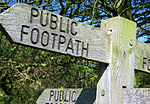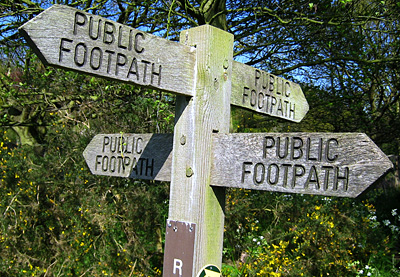Buying property and rights of way
Cheryl Markosky looks at the ins and outs of buying a property with a right of way across it


Few things can split a rural community more sharply than footpaths and rights of way over land. Ardent fans of The Archers will know how heated the Lynda Snells of this world can become when a public footpath is threatened by a landowner. Recently in the radio show, Adam Macy courted controversy when he planned on diverting a footpath at Home Farm so he could expand his polytunnel business. A compromise was reached when his father gave the village some land in exchange for the right to reroute the path.
House finder Robin Gould from Prime Purchase in the South-West says the radio soap isn't far from the truth, with footpaths and public rights of way making most country-house purchasers jumpy. Yet, he doesn't regard a right of way as a major setback. ‘Generally, most users of paths and bridleways respect a homeowner's privacy and property, which can be fenced by hedges to keep them away from gardens and fields with valuable stock.'
Kevin Allen from John D. Wood in Lymington isn't as optimistic, stating he'd advise buyers to steer clear of a property with a right of way going through it. ‘It won't be easy to move and there's always someone who's walked his dog there for 40 years adamant everything should remain as it is.' Another difficulty, according to Mr Allen, is the propensity for vendors to insist having a right of way over their land has never presented a problem. He never believes what the seller says, and advises interested buyers to turn up armed with a flask to check out the path at different times of the day, counting the number of walkers and vehicles.

Any prospective purchaser should start by determining what sort of right is in place. An easement is the right to use another person's land for a stated purpose, such as being allowed to cross over to access a forest. It might also give a utility company the right to erect power lines or bury a gas pipeline. Usually, easements are included in a deed and remain in place if the land is sold.
A right of way is a type of easement that gives someone the right to travel across property owned by another person. Mr Gould suggests checking properties that were once the hub of many paths, such as converted watermills. Redirecting a footpath can be a lengthy and costly process, requiring approval from local or district councils, and is unlikely to be successful if there's local opposition. Solicitor Suzanne Bowman from Adams & Remers also cautions buyers over occupier's liability. ‘If someone trips over your statuary while walking on a footpath and injures themself, they could sue you, so it's a good idea to take out insurance.'
Another right of way where buyers must be vigilant is an informal agreement between neighbours. ‘A former occupant might have allowed someone to cross through your orchard, using it as a shortcut to the church. This friendly arrangement might not be in writing, so you need to talk to locals to discover the practice. It will only cost a couple of hundred pounds to pay a lawyer to lodge a new deed with the Land Registry terminating the custom,' she says. Although disused railway lines backing on to a property might provide wonderful spaces to walk the dog, ride horses or allow children to ride their bikes, there can be security issues, adds Mrs Bowman.
Some sellers are blissfully unaware of a right of way on their land, or suffer from temporary amnesia, claims Nick Forman of Freeman Forman in East Sussex. He had one client who said his land wasn't affected by any footpaths, and when one that ran literally outside his front door cropped up in a solicitor's search, the buyer withdrew from the sale. ‘A right of way won't render a home unsell-able, but it can dramatically reduce its value by 30%-40%.'
Exquisite houses, the beauty of Nature, and how to get the most from your life, straight to your inbox.
Conversely, in some instances, a right of way can actually enhance a property's worth, adds Mr For-man. He's selling £1.25 million Rodgers Farm, a detached farmhouse in Westfield with stabling, manège and paddocks set in more than 43 acres of land. A bridleway is adjacent to the boundary of the property, which appeals to equestrians. ‘They can just pop out of the gate and enjoy a pleasant ride without having to box up the horses.'
* For more property stories like this every week, subscribe and save
Before you buy
* Spend time observing any rights of way to determine frequency of usage
* Check for easements in the deeds
* Lodge a new deed with the Land Registry to terminate informal agreements made by previous owners, if necessary
Country Life is unlike any other magazine: the only glossy weekly on the newsstand and the only magazine that has been guest-edited by His Majesty The King not once, but twice. It is a celebration of modern rural life and all its diverse joys and pleasures — that was first published in Queen Victoria's Diamond Jubilee year. Our eclectic mixture of witty and informative content — from the most up-to-date property news and commentary and a coveted glimpse inside some of the UK's best houses and gardens, to gardening, the arts and interior design, written by experts in their field — still cannot be found in print or online, anywhere else.

